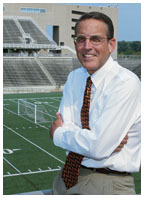
|
October 11, 2006: A moment with...
(Photo by Beverly Schaefer) |
Gary Walters ’67
Director of Athletics Gary Walters ’67 recently became chairman of the NCAA Division I men’s basketball committee, taking a key role in one of the most popular events in college athletics. The men’s basketball tournament is the crown jewel of the NCAA’s 11-year, $6-billion television contract with CBS, which helps fund a range of NCAA initiatives. Walters shared his thoughts on the committee’s work and other hot topics in college sports with PAW’s Brett Tomlinson.
More than 12 million households watched the NCAA tournament final on television last year. Why do you think it appeals to so many fans?
It captures American culture. In some ways, what we’ve done in the college basketball tournament is a great compromise. ... What you have, through the 31 automatic qualifiers for conference champions, is a mechanism for broad-based access that gives every university an equal opportunity to compete. We balance that with the 34 at-large teams — the teams that we think are the 34 best at-large teams in the country. That’s the pure meritocracy part. I think what the committee has been able to achieve is the sweet spot between meritocracy and opportunity.
One of the most important, and most critiqued, jobs in all of sports is the work done by your committee in selecting teams for the tournament. What goes into that process?
A lot of people have a sketchy impression of what we do, and there are many who believe that we rely only upon quantitative methods. The quantitative method that we use within the NCAA is this model called the RPI, the Ratings Percentage Index. It’s simply a winning percentage index — a mathematical model that enables us to get a general indication of relative team strength. The RPI basically creates the skeleton. It’s the job of the committee to create the corpus, to fill out the figure. And we do that in a very subjective way by trying to analyze and compare the strengths and weaknesses of the best teams in the “major” and so-called mid-major conferences.
This year, the Ivy League is celebrating its 50th anniversary. Based on your experience as a student-athlete, coach, and athletic director, how do you think college athletics and the Ivy League have changed in the last 50 years?
The most obvious change that has taken place in the last 50 years is the fact that Princeton, as well as other schools, is co-ed. But more importantly, Title IX [passed in 1972] obviously has had a dramatic and positive impact on the role of athletics in all of our institutions. ... The second major change, however, is that in order to accommodate Title IX and coeducation, universities had to eliminate freshman teams, which had an enormous impact on the freshman student-athlete experience. The period of adjustment for freshmen has been reduced and both the academic and athletic pressure has intensified. And in that way, I think athletics today, generally speaking, are more difficult than they were when I played.
Third, despite public perceptions that have been erroneously influenced by recent books that have focused on the role of athletics at selective universities, we have 20 percent fewer recruited athletes on our Ivy League campuses [including Princeton] today than we had just 20 years ago. ... And fourth, again notwithstanding some of the perceptions that are out there, never in the history of the University has the athletic cohort itself been more representative of the overall student body because of the Ivy League’s decision to implement the academic index [AI] back in the early 1980s. There has been a compression of the standard deviation of the AI of athletes versus the mean of the overall class, every year.
Looking at college athletics nationally, last year there were a handful of incidents that cast teams in a negative light, including an off-campus men’s lacrosse party at Duke that led to criminal charges of rape and sexual assault. What can Princeton do to prevent such incidents?
My job is to create an athletic culture that is consistent with the
educational mission of the University. Toward that end we hire educator-coaches
who can serve as good role models for our student-athletes. By definition,
however, college students sometimes go too far in exerting their independence.
We have to use those occasions constructively as teachable moments, understanding
that discipline may be required to appropriately address a situation.
One of the things that we became engaged with about eight or nine years
ago, through the University’s alcohol initiative, is [that] every
year, our teams submit plans of action as to the use of alcohol. Every
year, we also talk with our athletes about our zero-tolerance policy on
hazing. I don’t think we could be any more transparent or straightforward
as it relates to what our expectations are. ![]()
MORE ON THE WEB: An extended interview with Gary Walters ’67, click here.

